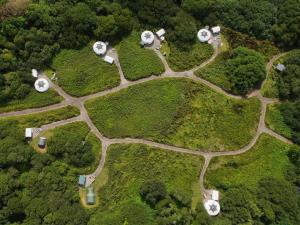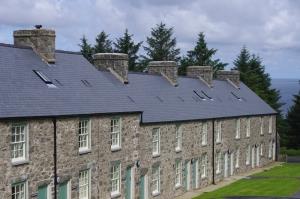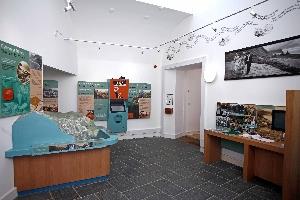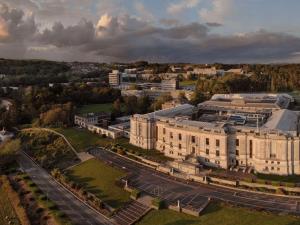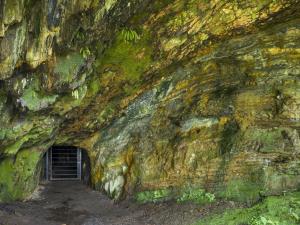JRR Tolkien (1892 - 1973) loved the Welsh language, describing Welsh as ‘…the senior language of the men of Britain.’ He gave Welsh-inspired names to many characters and places in The Lord of the Rings and The Hobbit. To relive the magic of his books, visit these places with a connection to Tolkien’s work.

Llanbedrog, Llŷn Peninsula
As a boy, Tolkien lived near a railway station in Birmingham, where Welsh words appeared magically into his life. He later said, ‘I heard it coming out of the west, it struck me in the names on coal trucks and drawing nearer it flickered past on station-signs, a flash of strange spelling and a hint of a language old and yet alive. It pierced my linguistic heart.’ His fascination with Welsh continued on a family holiday to Llanbedrog on the Llŷn Peninsula in 1920. He later used Welsh in his novels as the foundation of one of the Elvish languages, Sindarin.


Bannau Brycheiniog (Brecon Beacons) National Park
It’s thought (but not proved) that Tolkien stayed in the appealing village of Talybont-on-Usk in the 1940s, while working on parts of The Lord of The Rings. Writing at a time when industrialisation was transforming the British countryside, his nostalgic depiction of The Shire was inspired by rural Wales. It’s easy to see similarities between the landscapes in his books and the hills and meadows of the Black Mountains. He named the Hobbit settlement of Crickhollow after nearby Crickhowell.



Lammas Ecovillage, Pembrokeshire
There’s a Hobbit-house atmosphere to the homes at Lammas, an ecovillage created by a group of people committed to low-impact living. Their idea is to pioneer an alternative model for living on the land. Residents offer 90-minute guided tours of the village at 11am every Saturday from May to September, and courses in traditional crafts are held on a regular basis.

Hobbit houses, Pembrokeshire
Four grass-roofed Hobbit houses are among the glamping options at Florence Springs, a quietly beautiful settlement in the heart of Pembrokeshire. They’ve all got private wood-burner hot tubs, and they’re close to the beautiful beaches of Tenby.



Nant Gwrtheyrn, Llŷn Peninsula
Tolkien felt the study of Welsh was crucial to his understanding of the history of the British Isles, saying, ‘Welsh is of this soil, this island, the senior language of the men of Britain; Welsh is beautiful.’ If you are equally fascinated by Celtic culture and the Welsh language, head for Nant Gwrtheyrn, a peaceful language and heritage centre in a former quarrymen’s village on the north coast of the Llŷn Peninsula.
You can drop in for the day to enjoy heritage exhibits and a café with sparkling sea views, or join a residential course.

Gladstone's Library, Hawarden
An academic by profession, Tolkien would have felt thoroughly at home in this sumptuous residential library. Gladstone's Library holds 32,000 books from Prime Minister William Ewart Gladstone’s private collection, many of them hand-annotated, just as Tolkien annotated his own volumes. ‘Learn Welsh in a Week’ is among the many language and literary courses held here.


Narberth Museum, Narberth
Tolkien studied the Mabinogion, a collection of Celtic myths and Arthurian legends from medieval Welsh manuscripts, and wove some of their themes into his works. In fact, he claimed that The Lord of the Rings was his own translation of the mythical ‘Red Book of Westmarch’ – based on the real-life Red Book of Hergest, one of the oldest and most important Welsh manuscripts. You can introduce your kids to the best-known tales at Narberth Museum's Mabinogion Woodland Glade, a play area with space for story-telling, puzzles and dressing up.


National Library of Wales, Aberystwyth, Ceredigion
The mind-bogglingly large collection of books at our National Library, adjacent to Aberystwyth's prestigious university, includes rare Welsh manuscripts. Among them is another important source of Mabinogion stories, the White Book of Rhydderch, which dates back to the mid 14th century. It’s one of the most notable manuscripts in Wales.

Dolaucothi Gold Mines, Carmarthenshire
If the scenes of Smaug the dragon with his enormous hoard of gold in The Hobbit made you curious about how Welsh gold was mined, you’ll be gripped by the underground guided tour of Dolaucothi Gold was extracted here from Roman times until 1938, the year after the book was published.


